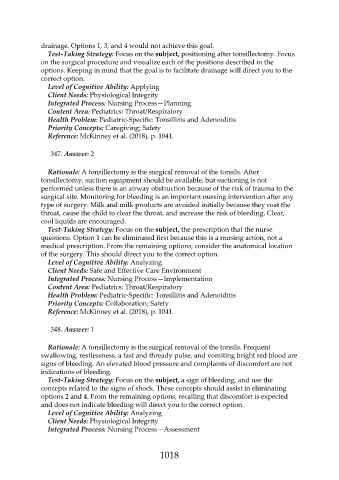Page 1018 - Saunders Comprehensive Review For NCLEX-RN
P. 1018
drainage. Options 1, 3, and 4 would not achieve this goal.
Test-Taking Strategy: Focus on the subject, positioning after tonsillectomy. Focus
on the surgical procedure and visualize each of the positions described in the
options. Keeping in mind that the goal is to facilitate drainage will direct you to the
correct option.
Level of Cognitive Ability: Applying
Client Needs: Physiological Integrity
Integrated Process: Nursing Process—Planning
Content Area: Pediatrics: Throat/Respiratory
Health Problem: Pediatric-Specific: Tonsillitis and Adenoiditis
Priority Concepts: Caregiving; Safety
Reference: McKinney et al. (2018), p. 1041.
347. Answer: 2
Rationale: A tonsillectomy is the surgical removal of the tonsils. After
tonsillectomy, suction equipment should be available, but suctioning is not
performed unless there is an airway obstruction because of the risk of trauma to the
surgical site. Monitoring for bleeding is an important nursing intervention after any
type of surgery. Milk and milk products are avoided initially because they coat the
throat, cause the child to clear the throat, and increase the risk of bleeding. Clear,
cool liquids are encouraged.
Test-Taking Strategy: Focus on the subject, the prescription that the nurse
questions. Option 1 can be eliminated first because this is a nursing action, not a
medical prescription. From the remaining options, consider the anatomical location
of the surgery. This should direct you to the correct option.
Level of Cognitive Ability: Analyzing
Client Needs: Safe and Effective Care Environment
Integrated Process: Nursing Process—Implementation
Content Area: Pediatrics: Throat/Respiratory
Health Problem: Pediatric-Specific: Tonsillitis and Adenoiditis
Priority Concepts: Collaboration; Safety
Reference: McKinney et al. (2018), p. 1041.
348. Answer: 1
Rationale: A tonsillectomy is the surgical removal of the tonsils. Frequent
swallowing, restlessness, a fast and thready pulse, and vomiting bright red blood are
signs of bleeding. An elevated blood pressure and complaints of discomfort are not
indications of bleeding.
Test-Taking Strategy: Focus on the subject, a sign of bleeding, and use the
concepts related to the signs of shock. These concepts should assist in eliminating
options 2 and 4. From the remaining options, recalling that discomfort is expected
and does not indicate bleeding will direct you to the correct option.
Level of Cognitive Ability: Analyzing
Client Needs: Physiological Integrity
Integrated Process: Nursing Process—Assessment
1018

